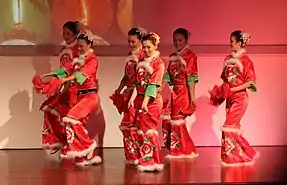Yaogu
The yaogu is a traditional Chinese drum instrument.[1] It is the symbol of Chinese drums. It displays unique forms and traditional customs.
It is played on people's waists, using hands or two wooden sticks.[2]
History
In ancient times, in the Yellow River valley, the male in every tribe wrapped sheepskins around the trunk of a tree and carried it at his waist, to drive beasts away from the tribes.[3]
The first percussion instrument originated four thousand years ago in China in the neolithic Shang Dynasty. Percussion instruments were widely used in celebration of the dynasty and the conflicts.[4] Drums symbolized spirit and power and represented the universe.[5]
Dating to the Qing and Han Dynasties, the yaogu was used to send signals to frontier guards, to inform their leaders that enemies were approaching.[6] People played the Yaogu to celebrate the harvest.[7] It is believed that the sound of the yaogu brings luck to local areas during prayer.

At the beginning of the 20th century, the yaogu was combined with dance when the peasants were working in the fields. In order to recover from fatigue and boredom, peasants in northwest China developed a dance named "Yangko" from fieldwork. Yangko (also named Yangge) remains a popular rural folk dance.[8]
Dance movements
Yaogu performers are full of energy. They move their bodies with the beats of drums and musical rhythm to express passions. Performers shake their heads and wave their shoulders strongly combining dancing movements with personal emotions.[9][10]
Performing form
Yaogu can also play a leading part in a performance by standing in front of an orchestra.[11]

Culture
The Yaogu opened a channel for traditional Chinese percussion instruments.[12]
The Yaogu illustrates the simple and unconstrained character of the farmers in the northwest loess plateau. It expresses the collective spirit of the Shanxi people and good wishes for life.[13]
References
- "Chinese Waist Drum, Yaogu: A Chinese Musical Instrument". www.topchinatravel.com. Retrieved 2019-01-16.
- Su-Il, Jeong (2016). The silk road encyclopedia (English ed.). Irvine, CA: Seoul Selection. ISBN 978-1624120763. OCLC 955004028.
- Xi bu zhi lian., Yang, Shulin., Lu, Yuan., Guangzhou Shi xin shi dai, 2008, ISBN 9787885256180, OCLC 771858552CS1 maint: others (link)
- scholar), Jin, Jie (Music (2011). Chinese music. Wang, Li., Li, Rong. (Updated ed.). Cambridge: Cambridge University Press. ISBN 9780521186919. OCLC 671710042.
- Asian American religious cultures. Lee, Jonathan H. X.,, Matsuoka, Fumitaka,, Yee, Edmond, 1938-, Nakasone, Ronald Y. Santa Barbara. ISBN 9781598843309. OCLC 895731298.CS1 maint: others (link)
- Luo, Qi (2015-05-27). Sports Engineering and Computer Science : proceedings of the 2014 International Conference on Sport Science and Computer Science (SSCS 2014), Singapore, 16-17 September 2014 & the 2014 International Conference on Biomechanics and Sports Engineering (BSE 2014), Riga, Latvia, 24-25 October, 2014. Luo, Qi,, International Conference on Sport Science and Computer Science (2014 : Singapore), International Conference on Biomechanics and Sports Engineering (2014 : Riga, Latvia). Boca Raton, FL. ISBN 9781315755717. OCLC 910237206.
- Survey of China Mainland Press. American Consulate General. September 1971.
- James, DeMare, Brian (2015-04-02). Mao's cultural army : drama troupes in China's rural revolution. Cambridge. ISBN 9781107076327. OCLC 897510462.
- "The Joy of the Chinese Waist Drum Dance - Vision Times". www.visiontimes.com. Retrieved 2018-11-02.
- 1981-, Wilcox, Emily. Revolutionary bodies : Chinese dance and the socialist legacy. Oakland, California. ISBN 9780520971905. OCLC 1043052885.CS1 maint: numeric names: authors list (link)
- Chime : newsletter of the European Foundation for Chinese Music Research. Shanghai: European Foundation for Chinese Music Research. 1990. p. 43.
- Su-Il, Jeong (2016). The silk road encyclopedia (English ed.). Irvine, CA: Seoul Selection. ISBN 978-1624120763. OCLC 955004028.
- "The Joy of the Chinese Waist Drum Dance - Vision Times". www.visiontimes.com. Retrieved 2018-11-02.